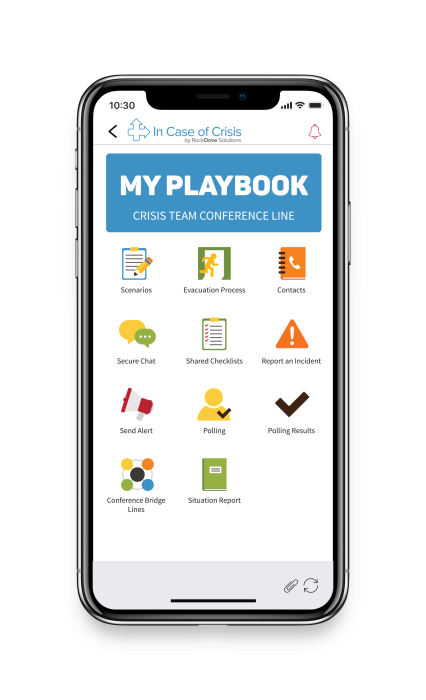The fully-digitized, omnichannel world can be a marketer’s dream around a new product launch or other brand messaging. It can also accelerate bad news. A crisis can travel halfway around the globe before a communications team has put on their proverbial shoes.
It doesn’t have to be this way. Digital problems call for digital solutions. RockDove Solutions developed an app for that called In Case of Crisis, now in the hands of over 750 corporate clients.
RockDove COO Chris Britton told me most companies have some kind of crisis manual on their premises, hidden on a dusty backroom shelf.
Since launching in 2012, the app has helped companies organize their workforce to meet a crisis according to new principles in the digital age. They are continually updating best practices, but one constant remains – the need for immediate action.
While protocols are tailored to specific companies depending on their crisis strategy and organizational structure, general principles are covered in the newly updated eBook, The New Rules of Crisis Management.
“The app came about after a series of mishandled crises in the news,” Britton explained. “We recognized some of the challenges to companies included having the right information in the right hands at the right time.”
He added that one way or another, the story about the crisis will be told. Mobile devices make everybody a potential roving reporter through any of the most popular social media.
RockDove spun off from a defense contractor in 2014, in order to handle the growth they were experiencing as more companies signed on as app users.
“In Case of Crisis was developed in order to support crisis and emergency preparedness,” said Britton. “When we started, the app provided company access to their referential crisis plan. Then, it became obvious to develop a whole workflow and set of communications services.”
The app links up with crisis solution software like Everbridge so that action can be taken once the crisis is underway.
Britton estimates that the majority of companies don’t have an updated crisis plan in place, even when data breaches and cyber attacks frequently occur for companies in all industries, as just one example of the risk involved.
“What you see in the news every day, and what we hear when we talk to clients, is that the ability to respond in a quick way is the biggest challenge,” said Britton. “Sure, people can put things out there quickly. But if it’s not right, they face a reaction. Being able to respond quickly and effectively is a huge challenge for different organizations facing crises when they don’t have plans in place.”
An app that refreshes and updates makes it possible for the crisis protocol to be executed. But the other advantage of having everything digitally transformed is that a company can train.
“The more that folks train and drill, the better they respond to a critical event,” Britton stated. “Having an app approach helps them create the muscle memory that will help them during a crisis.”
Britton suggests that companies use efficient communications to mobilize their PR professionals and the appropriate leadership immediately. This way, they get the “right person in front of the camera.” Otherwise, the story will be covered at rapid speed over social media, without any of the company’s say.
“Creating thoughtful, smart protocols allows companies to have the appropriate steps to provide a response,” Britton commented. “Organizations should tell the truth and shouldn’t get in front of their headlights. This way, they can get the right people in the media to tell the story, and respond both in social media and through traditional media in an effective and honest way.”
Modern day crises range from operations risks, workplace violence, political unrest and reputation-related challenges stemming from product recalls for brands, as well as corporate malfeasance. Increasingly, data breaches are a major issue where companies will suffer public admonishment if they elect not to be quick to the punch and talk about it.
Britton mentioned the major Equifax breach from 2017.
“The chose to not discuss or disclose the breach publicly until months after it was known internally,” he said. “They lost an incredible amount of public trust. Organizations are faced with the reality that because of the digital environment, nothing is going to be kept secret anymore. The best thing to do is address the problem head-on quickly and honestly.”








